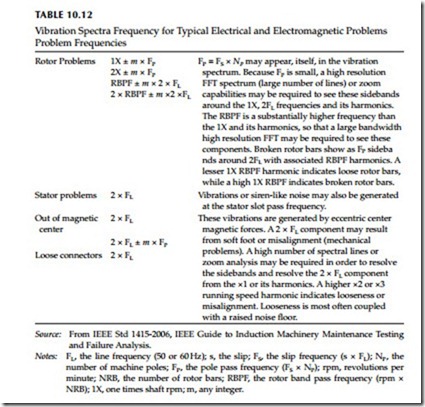Vibration Analysis
Vibration monitoring is perhaps the most beneficial test for rotating machines for identifying mechanical and electrical problems. Vibration analysis can monitor many abnormalities among them being wear, imbalance, misalignment, mechanical looseness, bearing damage, structural resonance, fatigue, etc.
Although diagnostics are sometimes based on a single vibration spectrum, as in most preventive and predictive maintenance programs, vibration spec- tra are acquired periodically and stored in a database. The data is then trended by searching for changes in levels at the problem or forcing frequen- cies. It is important that the trended data be acquired at the same location, in the same orientation, under the same operating conditions and with the same analyzer settings (frequency range, window type, number of spectral aver- ages, number of spectral lines, etc.) every time. For this reason, transducer- mounting pads permanently mounted on the machine are a good idea.
The most common transducer is typically an accelerometer. Of the three types of vibration transducers (noncontacting shaft vibration probes with proximeters, velocity pickups, and accelerometers), the accelerometer has the widest bandwidth. It is desirable to securely mount the accelerometer or velocity transducer as close as possible to the bearings. For large high-speed machines with hydrodynamic (sleeve) bearings, the use of noncontacting shaft vibration probes is recommended for vibration analysis.
Some of the mechanical problems detected by vibration spectra are imbal- ance, misalignment, looseness, bent shaft, and bearing problems. Identification of an electrical or mechanical problem depends upon the frequency spectra and the frequency relationship between running speed, electrical vibration, and other machine internal or driven-equipment components. The phase between accelerations at three locations (drive end bearing, opposite drive end bearing, and axial reading) may also be used in the diagnosis of problems. Readings should be taken on all bearings in the horizontal, vertical, and axial directions.
Electrical problems reflected in vibration spectra include machine out of magnetic center (uneven air gap, rotor not round or bent rotor, rotor and
stator misaligned, elliptical stator bore), loose connectors, open or shorted stator windings, and rotor bar irregularities or broken rotor bars. Generally, these problems are also reflected in the 1X and, possibly, 2X, or higher harmonic vibrations coupled with twice line frequencies (2FL) (most common with electrical vibration).
Monitoring the vibration levels as the electrical power is disconnected from the machine is one method used to determine if a vibration is due to mechanical versus electromagnetic or electrical problems. If the cause is primarily electrical/electromagnetic, vibration levels will drop immediately (whereas levels decrease only as the machine slows down if the problem is mechanical in origin). This type of test is referred to as a “coast-down” test. Vibrations associated with electrical/electromagnetic problems also tend to be load dependent. This is a reflection of the role that the machine slip frequency plays in the generation of these vibrations. The frequencies at which electrical and electromagnetic problems are reflected in vibration spectra are summarized in Table 10.12.
